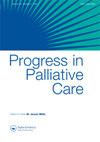标准化氯胺酮分步方案对癌症神经性疼痛的影响
IF 0.8
Q4 PUBLIC, ENVIRONMENTAL & OCCUPATIONAL HEALTH
引用次数: 1
摘要
麻醉下剂量的氯胺酮是一种有效的镇痛药。它在癌症疼痛中的应用仍不明确,方案在患者选择、起始剂量、滴定、使用持续时间和共同镇痛药的调整方面各不相同。目的研究标准化氯胺酮逐步方案对姑息治疗室(PCU)癌症疼痛的影响。方法这是一项标准化氯胺酮步骤方案的前瞻性队列研究,该方案是在PCU中开发的,用于癌症疼痛。氯胺酮皮下输注标准化起始剂量为75 24小时内服用氟哌啶醇5毫克 mg作为预防心理模拟副作用。氯胺酮的递增剂量遵循每日逐步方案。结果48例患者中,41例(85.4%)为癌症神经性疼痛。缓解能力量表评分中位数(PPSv2)为40%。平均数值评分(NRS)从6.74提高到2.61(P < 0.0001),平均百分比减少58.05%。实现稳定疼痛控制所需的最终平均每日氯胺酮剂量为137.50 31例(62.5%)患者在第3天达到疼痛控制。吗啡等效日剂量(MEDD)的平均减少量为130.34 mg至107.33 mg(P < 0.002),百分比减少18.85%。超过一半的患者完成了为期5天的方案,出现轻度至中度副作用,不需要紧急医疗干预,也不需要终止氯胺酮方案。结论在以神经性癌症疼痛为主的患者中,使用标准化的氯胺酮步骤方案可显著降低疼痛和MEDD。它还证明了一种安全有效的方法,在开始注射氯胺酮后减少阿片类药物。关键信息标准化氯胺酮方案如何影响癌症疼痛控制?我们的研究表明:肠外氯胺酮是一种强效镇痛药,可显著减轻癌症神经性疼痛患者的疼痛。这项研究还证明了一种安全有效的阿片类药物在注射氯胺酮后滴定的方法。同时使用精神药物也有助于减少心理模拟副作用,增加对氯胺酮的耐受性。本文章由计算机程序翻译,如有差异,请以英文原文为准。
The impact of a standardised ketamine step protocol for cancer neuropathic pain
Context Ketamine at sub-anesthetic doses is a potent analgesia. Its use in cancer pain remains equivocal with protocols varying in patient selection, starting dose, titration, duration of use and adjustment of co-analgesics. Objective To study the impact of a standardised Ketamine Step Protocol on cancer pain in a Palliative Care Unit (PCU). Methodology This is a prospective cohort study of a standardised Ketamine Step Protocol which was developed in a PCU for use in cancer pain. The subcutaneous ketamine infusion was standardised at a starting dose of 75 mg over 24 hours with Haloperidol 5 mg as prophylaxis against psycho-mimetic side effects. Incremental doses of ketamine followed the daily stepwise protocol. Result Of the 48 patients analysed, 41 (85.4%) had neuropathic cancer pain. The median Palliative Performance Scale score (PPSv2) was 40%. Mean Numerical Rating Score (NRS) improved from 6.74 to 2.61 (P < 0.0001) with a mean percentage reduction of 58.05%. The final mean daily ketamine dose needed to achieve stable pain control was 137.50 mg/day (±81.54). 31(62.5%) patients achieved pain control by day 3. The mean Morphine Equivalent Daily Dose (MEDD) reduction was from 130.34 mg to 107.33 mg (P < 0.002) with a percentage reduction of 18.85%. More than half of our patients completed the 5 d protocol with mild to moderate side effects not warranting urgent medical intervention nor termination of the ketamine protocol. Conclusion Use of a standardised Ketamine Step Protocol showed a statistically significant reduction in pain and MEDD in patients with predominantly neuropathic cancer pain. It also demonstrated a safe and effective method for opioid reduction after commencement of parenteral ketamine. Key Message How can a standardised ketamine protocol impact on cancer pain control? Our study shows that: Parenteral ketamine is a potent analgesic which significantly reduced pain in patients with cancer neuropathic pain. This study also demonstrated a safe and effective method for titration of opioids after parenteral ketamine is started. Concurrent use of psychotropics also helps to reduce psycho-mimetic side effects, increasing tolerability to ketamine.
求助全文
通过发布文献求助,成功后即可免费获取论文全文。
去求助
来源期刊

PROGRESS IN PALLIATIVE CARE
PUBLIC, ENVIRONMENTAL & OCCUPATIONAL HEALTH-
CiteScore
2.60
自引率
11.80%
发文量
24
期刊介绍:
Progress in Palliative Care is a peer reviewed, multidisciplinary journal with an international perspective. It provides a central point of reference for all members of the palliative care community: medical consultants, nurses, hospital support teams, home care teams, hospice directors and administrators, pain centre staff, social workers, chaplains, counsellors, information staff, paramedical staff and self-help groups. The emphasis of the journal is on the rapid exchange of information amongst those working in palliative care. Progress in Palliative Care embraces all aspects of the management of the problems of end-stage disease.
 求助内容:
求助内容: 应助结果提醒方式:
应助结果提醒方式:


